Air Quality
Air Quality
Air quality, both indoors and outdoors, plays a vital role in maintaining human health. The environments we inhabit significantly affect our well-being, productivity, and longevity, making it imperative to understand and address air quality challenges.
The Overlooked Danger of Indoor Air
We spend approximately 90% of our time indoors, yet the air we breathe in these spaces often contains pollutants at 2 to 5 times higher concentrations than outdoor air. In some cases, indoor pollutant levels can soar to ten times higher. These pollutants—ranging from dust to volatile organic compounds (VOCs)—pose substantial risks to our health and productivity.
Alarming Statistics on Pollution and Health
Globally, pollution is a silent killer, claiming the lives of approximately 9 million people annually—a staggering 16% of all deaths worldwide. To contextualize, pollution kills more people than wars, obesity, smoking, and malnutrition combined. This underlines the urgent need to prioritize air quality, especially indoors, where people spend most of their time.
Sources of Indoor Pollution
-
Volatile Organic Compounds (VOCs): These are emitted as gases from certain solids or liquids. VOCs can be
found in:
- Paints, lacquers, and paint strippers.
- Cleaning products, pesticides, and adhesives.
- Office equipment (e.g., copiers and printers) and craft supplies.
- Dust and Particles: Dirt, soil, brake and tire dust, coal dust, and microplastics.
- Smoke: Fire-related particles, smoke, and soot.
- Industrial Residues: Manufacturing and industrial dust.
The Environmental Protection Agency (EPA) highlights that VOC exposure, whether short- or long-term, can have adverse health effects, ranging from headaches and nausea to more severe conditions such as respiratory diseases and organ damage.
The Ripple Effect: Outdoor and Indoor Air Quality
Outdoor air quality issues, such as vehicle emissions, industrial pollution, and wildfires, directly influence indoor air quality. Without proper filtration and ventilation, these outdoor pollutants infiltrate indoor environments, exacerbating health risks for building occupants. This happens due to the fact that HVAC (Heating, Ventilation & Air Conditioning) units need to bring in fresh air into buildings to reduce Carbon Dioxide released from humans during normal breathing. Fresh outside air is needed, but the propblem arises when that air contains additional pollution and contaminents and proper filtration of the outside air of the building is not implemented.
Health and Productivity Implications
Poor indoor air quality has been linked to numerous adverse outcomes:
- Sick Building Syndrome: Symptoms such as headaches, dizziness, and fatigue arise when individuals spend prolonged periods in poorly ventilated buildings.
- Reduced Productivity: Workers in environments with suboptimal air quality report lower output and efficiency.
- Impaired Learning: Students in schools with inadequate air quality experience reduced cognitive performance and learning outcomes.
The Need for Measurement and Improvement
Indoor air quality must be measured and proven healthy to ensure the safety and well-being of occupants. Advances in air monitoring technology can help identify and mitigate harmful pollutants. By taking proactive steps to improve indoor air quality, we can reduce health risks, boost productivity, and enhance overall quality of life.
We spend 90% of our time indoors, where the concentrations of some pollutants are often 2 to 5 times higher than typical outdoor concentrations.
Indoor Air Quality Certification
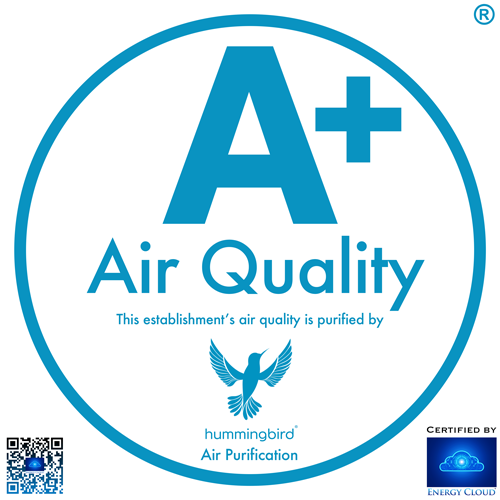
Air is one of the essential elements
of life, yet it is often taken for granted. - John Carrieri
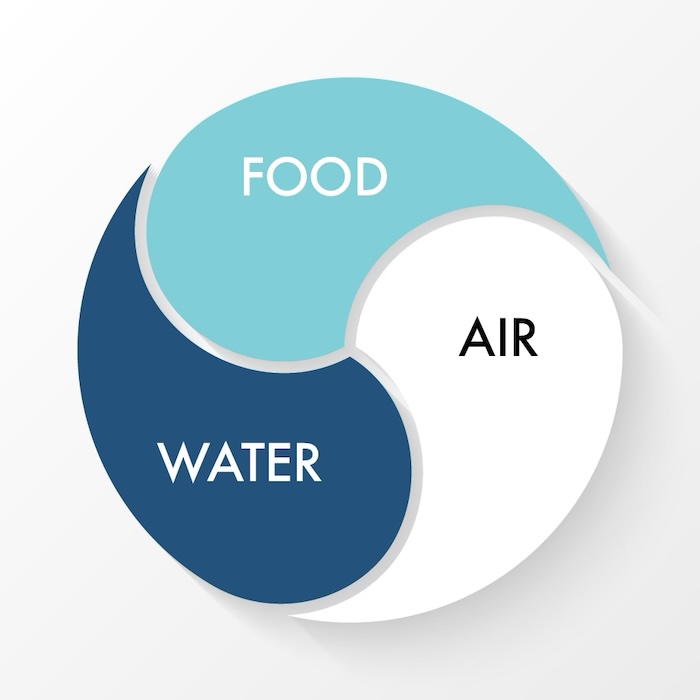

Hummingbird IAQ Indoor Air Quality Monitor Desktop Model
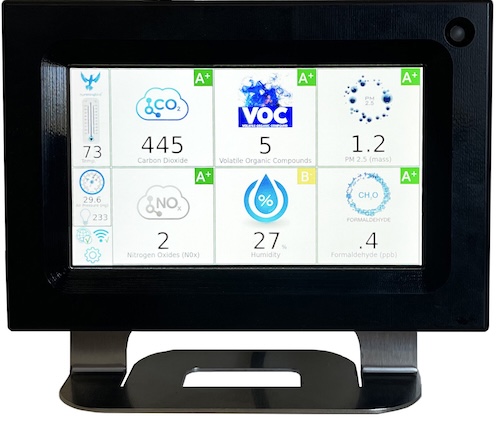
Airborne Viruses & Role of Hummingbird® Air Purification in Mitigation
Airborne viruses, such as influenza, rhinoviruses, and coronaviruses, pose significant public health challenges due to their mode of transmission through respiratory droplets and aerosols. These pathogens can remain suspended in the air for extended periods, increasing the risk of inhalation and subsequent infection. Mitigating the spread of airborne viruses is crucial, especially in indoor environments where ventilation may be limited.
Mechanisms of Airborne Transmission
Airborne viruses are expelled into the environment through activities like coughing, sneezing, talking, or even breathing. Once airborne, these viruses can:
- Travel distances: Depending on particle size and environmental conditions, viruses can travel varying distances.
- Remain viable: Some viruses can remain infectious in the air for hours, depending on factors like humidity and temperature.
- Infect individuals: Inhalation of virus-laden aerosols can lead to infection, even without direct contact with an infected person.
Mitigation Strategies
To reduce the transmission of airborne viruses, several strategies are employed:
- Ventilation: Increasing the flow of outdoor air into indoor spaces dilutes the concentration of viral particles.
- Filtration: High-efficiency particulate air (HEPA) filters can capture airborne viruses, reducing their presence in the environment.
- Air Purification: Advanced air purification systems such as the Hummingbird® system can deactivate viruses, rendering them non-infectious.
Hummingbird® Air Purification System
The Hummingbird® Air Purification System, developed by Energy Cloud, is an innovative solution designed to enhance indoor air quality by targeting airborne pathogens, including viruses. This system integrates multiple technologies to effectively capture and deactivate viruses present in the air.
Efficacy Against COVID-19 and Variants
Independent testing conducted at the University of Southern California (USC) Keck School of Medicine demonstrated the Hummingbird® system's effectiveness in deactivating airborne SARS-CoV-2, the virus responsible for COVID-19, along with its variants, including Omicron and Delta. The system achieved a deactivation rate of 99.99% on the first pass, indicating its potential as a long-term solution for maintaining indoor air quality.
USC Keck School of Medicine Hummingbird
Technological Features
The Hummingbird® system employs several advanced features:
- Photocatalytic Oxidation Chambers: These photocatalytic oxidation chambers facilitate chemical reactions that neutralize airborne pathogens.
- UVC Germicidal Lamps: Ultraviolet light effectively deactivates viruses by disrupting their genetic material.
- HEPA & MERV-13 High-Performance Filters: These filters capture a wide range of airborne particles, including viruses.
Advantages Over Traditional Systems
Unlike some air purification systems, the Hummingbird® does not produce harmful ozone or other byproducts during operation. Its design allows for integration into existing HVAC systems, making it adaptable for various indoor environments, including hospitals, schools, and commercial buildings. [Source]
Conclusion
Airborne viruses present a persistent threat to public health, particularly in enclosed spaces. The Hummingbird® Air Purification System offers a scientifically validated method to mitigate this risk by effectively deactivating viruses, including SARS-CoV-2 and its variants. Implementing such advanced air purification technologies is a proactive step toward enhancing indoor air quality and safeguarding public health.

Indoor Airborne Viruses
Volatile Organic Compounds (VOCs)
Volatile Organic Compounds (VOCs) are a diverse group of carbon-based chemicals that easily evaporate at room temperature, leading to their prevalence in indoor and outdoor air. Common sources of VOCs include paints, solvents, cleaning products, building materials, and furnishings. Exposure to elevated levels of VOCs can result in various health issues, ranging from short-term effects like headaches and dizziness to long-term consequences such as liver and kidney damage, and some VOCs are known carcinogens.
Mitigating VOC Exposure
To reduce exposure to VOCs, several strategies can be employed:
- Source Control: Selecting low-VOC or VOC-free products and ensuring proper storage of chemicals can significantly decrease indoor VOC levels.
- Ventilation: Enhancing indoor ventilation by opening windows or using mechanical systems helps dilute VOC concentrations.
- Air Purification: Utilizing air purification systems equipped with appropriate filtration technologies can effectively remove VOCs from indoor environments.
Hummingbird® Air Purification System
Hummingbird® Air Purification System, developed by Energy Cloud Inc., is an advanced solution designed to improve indoor air quality by targeting various airborne pollutants, including VOCs. This system integrates multiple technologies to effectively capture and neutralize VOCs, thereby reducing their concentration in indoor spaces.
Technological Features
The Hummingbird® system employs several advanced features:
- Photocatalytic Oxidation Chambers: These photocatalytic oxidation chambers facilitate chemical reactions that decompose VOCs into harmless C02 and water vapor, thereby reducing their presence in the air.
- UVC Germicidal Lamps: Ultraviolet light effectively deactivates biological contaminants, contributing to overall air purification.
- HEPA & MERV-13 High-Performance Filters: These filters capture a wide range of airborne particles, including some VOCs, enhancing the system's filtration efficiency.
Advantages Over Traditional Systems
Unlike some air purification systems, the Hummingbird® does not produce harmful ozone or other byproducts during operation. Its design allows for integration into existing HVAC systems, making it adaptable for various indoor environments, including hospitals, schools, and commercial buildings. [Source]
Conclusion
VOCs pose a significant threat to indoor air quality and human health. The Hummingbird® Air Purification System offers a scientifically validated method to mitigate this risk by effectively reducing VOC concentrations in indoor environments. Implementing such advanced air purification technologies is a proactive step toward enhancing indoor air quality and safeguarding public health.

Volatile Organic Compounds (VOCs)
Dangers of Particulate Matter in the Air & Risks to Human Health
Air pollution is a growing concern worldwide, and one of the most harmful components is particulate matter (PM). These tiny airborne particles pose significant health risks, particularly to the respiratory and cardiovascular systems. Particulate matter is classified based on size, with each category affecting human health differently. Additionally, viruses and bacteria can attach themselves to these floating particles, increasing the likelihood of disease transmission. Fortunately, advanced air purification technologies, such as the Hummingbird® Air Purification System, offer an effective solution to mitigate these risks and enhance indoor air quality.
Understanding Particulate Matter Sizes
Particulate matter is measured in microns (µm), with different sizes having varying levels of impact on human health:
- 0.5 Micron (PM0.5): These ultrafine particles can penetrate deep into lung tissues and even enter the bloodstream, leading to systemic health effects.
- 1 Micron (PM1.0): Slightly larger but still dangerous, these particles can remain airborne for long periods and exacerbate conditions such as asthma and bronchitis.
- 2.5 Micron (PM2.5): Among the most concerning, PM2.5 particles are small enough to reach the deepest parts of the lungs and have been linked to heart disease and lung cancer.
- 4 Micron (PM4.0): These medium-sized particles can cause irritation in the upper respiratory tract, leading to discomfort and increased mucus production.
- 10 Micron (PM10): While larger, these particles can still cause significant health problems, including coughing, throat irritation, and aggravated lung conditions.
The Health Risks of Particulate Matter
Exposure to airborne particulates has been linked to numerous health issues, including:
- Respiratory Diseases: PM exposure can trigger asthma attacks, chronic bronchitis, and other lung conditions.
- Cardiovascular Problems: Fine particles can enter the bloodstream, increasing the risk of heart disease, hypertension, and stroke.
- Immune System Suppression: Continuous inhalation of pollutants can weaken the immune response, making individuals more susceptible to infections.
- Cancer Risks: Long-term exposure to PM2.5 and smaller particles has been associated with increased risks of lung cancer and other serious conditions.
How Viruses and Bacteria Travel on Particulate Matter
Airborne particulates not only harm the respiratory system but also act as carriers for viruses and bacteria. These microorganisms attach to PM and remain suspended in the air, increasing the chances of airborne disease transmission. This phenomenon is particularly concerning in enclosed spaces such as offices, hospitals, and schools, where poor ventilation can further exacerbate the risk.
The Role of the Hummingbird® Air Purification System
To combat the dangers of particulate matter and associated microbial threats, the Hummingbird® Air Purification System provides a highly effective solution through its advanced technology:
- Photocatalytic Oxidation: The most important Hummingbird® technology, photocatalytic oxidation, is able to instantly neutralize viruses and bacteria on the first pass. This is crucial as the system can not only stop particulates from the filtration layer but also neutralize any virus or biologicals that adhere to the particulates.
- HEPA Filtration: Captures 99.97% of airborne particulates, including PM2.5 and smaller.
- Activated Carbon Filters: Absorb volatile organic compounds (VOCs), odors, and toxic gases.
- UV-C Light Technology: Kills bacteria and viruses by disrupting their genetic material.
- Smart Air Monitoring: Adjusts filtration levels in real-time to ensure optimal air quality.
Benefits of Using the Hummingbird® Air Purification System
- Improved Respiratory Health: Reduces airborne pollutants that trigger respiratory conditions.
- Decreased Disease Transmission: Eliminates harmful viruses and bacteria from indoor air.
- Better Overall Well-being: Ensures clean, breathable air for all occupants.
- Energy-Efficient and Eco-Friendly: Operates efficiently while maintaining superior air quality.
Conclusion
Particulate matter presents a serious health risk, affecting both the respiratory and cardiovascular systems while also serving as a carrier for airborne pathogens. The Hummingbird® Air Purification System offers an effective solution to combat these threats, ensuring cleaner, safer indoor environments. Investing in high-quality air purification technology is essential for protecting human health and improving overall building wellness.
 Air Quality: Particulate Matter
Air Quality: Particulate Matter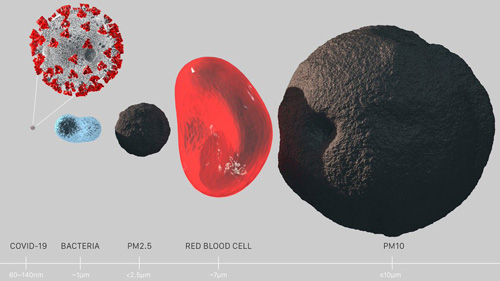 Air Quality: Particulate Matter Comparison
Air Quality: Particulate Matter Comparison
Air Quality and the Problem with Allergens in the Air
Air quality plays a crucial role in overall health and well-being, yet many people are unaware of the allergens and pollutants that can compromise indoor air. Allergens such as pollen, dust mites, pet dander, mold spores, and airborne particulates can trigger allergic reactions, exacerbate respiratory conditions, and reduce overall quality of life. Poor indoor air quality can lead to chronic health issues, particularly for individuals with asthma, allergies, and other respiratory sensitivities. Fortunately, advanced air purification technology, such as the Hummingbird® Air Purification System, offers a comprehensive solution to mitigate these issues and ensure a cleaner, healthier indoor environment.
Common Allergens in Indoor Air
Indoor air contains a variety of allergens that can negatively impact human health. Some of the most common include:
- Pollen: Tiny airborne particles from trees, grasses, and flowers that can easily enter homes and trigger seasonal allergies.
- Dust Mites: Microscopic organisms that thrive in bedding, carpets, and upholstery, contributing to respiratory problems.
- Pet Dander: Small skin flakes shed by animals that can cause allergic reactions in sensitive individuals.
- Mold Spores: Fungal particles that grow in damp environments, leading to respiratory issues and allergic responses.
- Volatile Organic Compounds (VOCs): Gases emitted from household products, paints, and cleaning agents that can cause irritation and long-term health concerns.
The Health Effects of Allergens
Exposure to airborne allergens can lead to a range of health problems, including:
- Respiratory Irritation: Allergens can inflame the airways, leading to symptoms such as coughing, wheezing, and difficulty breathing.
- Allergic Reactions: Sneezing, runny nose, itchy eyes, and skin rashes are common allergic responses to indoor allergens.
- Asthma Exacerbation: Allergens are a major trigger for asthma attacks, making it essential to reduce exposure.
- Fatigue and Cognitive Effects: Poor indoor air quality can lead to brain fog, headaches, and reduced concentration levels.
How the Hummingbird® Air Purification System Improves Indoor Air Quality
The Hummingbird® Air Purification System is designed to effectively remove allergens and pollutants from indoor air, improving air quality and enhancing health. It utilizes cutting-edge technologies to capture, neutralize, and eliminate harmful airborne contaminants:
- HEPA Filtration: Captures 99.97% of airborne allergens, including pollen, dust mites, and pet dander, preventing them from circulating indoors.
- Activated Carbon Filters: Absorb VOCs, odors, and harmful gases, reducing irritation and ensuring fresher indoor air.
- UV-C Light Technology: Neutralizes bacteria, mold spores, and viruses, further improving air hygiene.
- Photocatalytic Oxidation: Photocatalytic oxidation, the most advanced feature of the Hummingbird® system, this technology instantly neutralizes viruses, bacteria, and mold spores on the first pass. By breaking down harmful biological contaminants, it ensures that allergens and pathogens are not only filtered out but also rendered harmless.
- Smart Air Quality Monitoring: Continuously detects air quality levels and adjusts purification settings in real-time to maintain optimal indoor conditions.
The Direct Benefits to Human Health
By effectively reducing allergens and airborne pollutants, the Hummingbird® Air Purification System provides significant health benefits, including:
- Improved Respiratory Health: Fewer allergens in the air mean reduced asthma flare-ups, easier breathing, and overall lung health improvement.
- Reduced Allergy Symptoms: The system minimizes common allergy triggers, leading to relief from sneezing, congestion, and eye irritation.
- Enhanced Sleep Quality: Cleaner air promotes better sleep by reducing nighttime allergies and respiratory discomfort.
- Stronger Immune Function: Lower exposure to airborne pathogens helps strengthen the immune system, reducing the risk of infections.
- Better Overall Well-being: Breathing clean air leads to increased energy levels, improved cognitive function, and overall enhanced quality of life.
Conclusion
Indoor air quality is an essential factor in maintaining health and wellness, particularly for individuals with allergies or respiratory conditions. Allergens such as pollen, dust mites, mold spores, and pet dander can significantly impact well-being, but the Hummingbird® Air Purification System provides an effective solution. Through its advanced filtration, photocatalytic oxidation, and real-time air monitoring, the system ensures a cleaner and healthier indoor environment. Investing in high-quality air purification technology is a proactive step toward reducing allergens and improving overall indoor air quality for a healthier, more comfortable life.
 Air Quality: Pet Dander
Air Quality: Pet Dander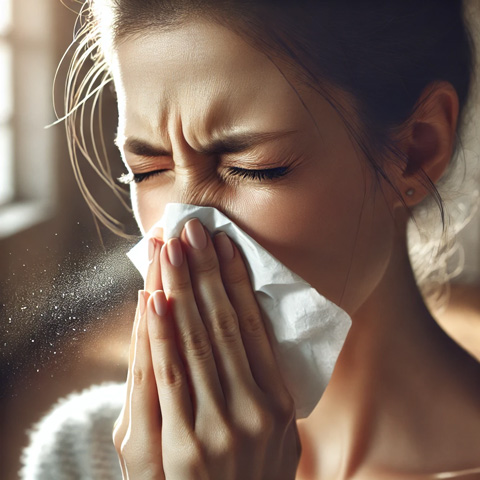
Air Quality: Allergies cause coughing / sneezing
The Health Risks of Mold and Common Types of Mold
Mold is a type of fungus that thrives in damp, warm, and humid environments. It can be found both indoors and outdoors and can pose serious health risks to humans. Mold exposure can lead to allergic reactions, respiratory issues, and infections, particularly in individuals with weakened immune systems. Understanding the types of mold and their potential health hazards is essential for prevention and control.
Health Risks of Mold
Exposure to mold can result in various health problems, including allergic reactions, asthma attacks, respiratory infections, and toxic effects due to mycotoxin exposure. Symptoms of mold exposure include sneezing, coughing, wheezing, skin irritation, eye irritation, and difficulty breathing. Prolonged exposure to mold can exacerbate preexisting health conditions, such as chronic lung diseases and immune system disorders.
Common Types of Mold
Numerous mold species exist, but some are more common and harmful than others. Below is an overview of significant mold types and their potential health risks:
- Stachybotrys Chartarum: Also known as "black mold," this toxic mold produces mycotoxins capable of causing severe respiratory problems, neurological issues, and immune suppression. It thrives in damp areas, such as water-damaged buildings.
- Alternaria: An allergenic mold commonly found in damp areas like showers and sinks. Exposure to Alternaria can trigger asthma attacks and allergic reactions.
- Cladosporium: Found on fabrics, carpets, and wood surfaces. It can cause respiratory infections, skin irritation, and allergy symptoms.
- Penicillium: Known for its antibiotic properties, but some strains can be harmful, causing respiratory infections, sinusitis, and allergic reactions.
- Cryptococcus Neoformans: Affects immunocompromised individuals, causing severe lung infections and meningitis.
- Histoplasma Capsulatum: Found in soil contaminated with bird or bat droppings, causing histoplasmosis.
- Trichoderma: Found in damp environments, with some strains triggering allergic reactions.
- Acremonium: A toxigenic mold linked to immune system suppression and severe infections.
- Aspergillus: A common indoor mold that can cause allergic reactions, lung infections, and aspergillosis.
- Aureobasidium: Found on wooden surfaces, painted walls, and caulking, causing skin and eye infections.
- Chaetomium: Found in water-damaged buildings, causing skin and nail infections.
- Mucormycetes: Can cause mucormycosis, a serious fungal infection affecting the sinuses, brain, and lungs.
- Serpula: Primarily causes dry rot in wood structures rather than health risks.
- Ulocladium: Thrives in water-damaged areas, causing allergic reactions and respiratory distress.
- Fusarium: Grows on water-damaged surfaces and produces dangerous mycotoxins.
Mitigating Mold with the Hummingbird Air Purification System
The Hummingbird® Air Purification System provides advanced purification technologies designed to improve indoor air quality and reduce health risks associated with mold exposure.
Key Technologies in the Hummingbird Air Purification System
- Photocatalytic Oxidation (PCO): The most significant technology in the system, PCO breaks down mold spores at a molecular level, eliminating harmful contaminants.
- HEPA Filtration: Captures and removes airborne mold spores and other particulates from the air.
- Activated Carbon Filters: Absorbs volatile organic compounds (VOCs) and musty odors.
- Ultraviolet (UV-C) Light: Destroys mold spores, bacteria, and viruses by disrupting their DNA.
By removing mold spores from the air, the Hummingbird Air Purification System effectively reduces mold spread and prevents further contamination.
Enhancing Mold Prevention with the Hummingbird® IAQ Monitor
Another essential tool in mold prevention is the Hummingbird® IAQ (Indoor Air Quality Monitor) system. This advanced monitoring system tracks 18 different air quality and environmental variables, including humidity, a key factor in mold prevention. By maintaining proper humidity levels, homeowners and facility managers can reduce the conditions that promote mold growth.
Monitoring humidity levels with the Hummingbird® IAQ ensures timely adjustments to ventilation, dehumidifiers, or air conditioning systems, further supporting a mold-free indoor environment. Combined with the Hummingbird Air Purification System, the IAQ monitor provides a comprehensive approach to maintaining healthier indoor air quality.
Ideal Humidity Levels for Mold Prevention
According to research, the ideal indoor humidity levels should be maintained between 40% and 60% relative humidity (RH) to reduce the risk of mold growth. Keeping humidity within this range helps prevent excessive moisture accumulation, which creates the perfect environment for mold to thrive. This recommendation is supported by a study available at National Library of Medicine: PMC. Proper humidity management, combined with air purification and monitoring, significantly enhances indoor air quality and minimizes mold-related health risks.
Conclusion
Mold exposure can pose significant health risks, particularly for individuals with respiratory conditions or weakened immune systems. Understanding different types of mold and their effects is essential for effective prevention and remediation. Utilizing advanced air purification systems like the Hummingbird Air Purification System, along with monitoring indoor conditions using the Hummingbird® IAQ (Indoor Air Quality Monitor), can help minimize mold growth and protect overall health.
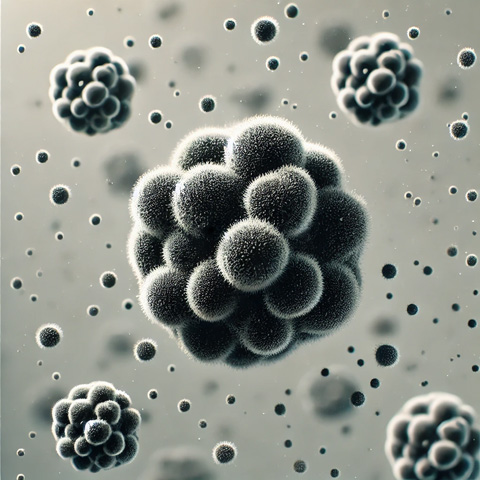 Air Quality: Black Mold Spores
Air Quality: Black Mold Spores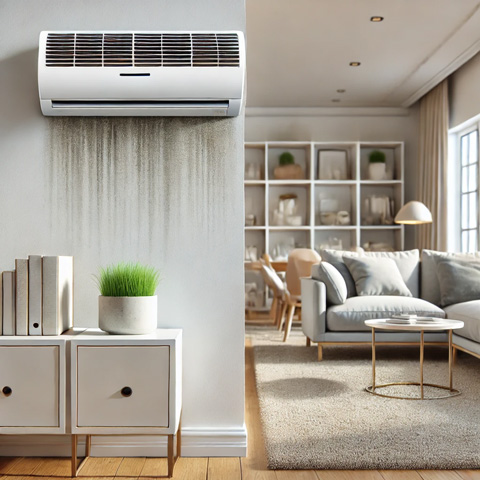 Black Mold Spores around HVAC vent.
Black Mold Spores around HVAC vent.
Odor / Smells
Air quality is an essential aspect of environmental health, impacting human well-being, comfort, and productivity. One of the key indicators of air quality is odor, which can signal the presence of pollutants, contaminants, or natural compounds. Understanding the sources of odor and effective ways to mitigate unpleasant smells is crucial for maintaining a healthy indoor and outdoor environment.
Sources of Odor and Smells
Odors in the air can originate from a variety of sources, including:
1. Biological Sources
- Mold and mildew growth in damp environments
- Bacterial activity leading to foul-smelling gases
- Pet dander and animal waste
- Decomposing organic matter
2. Chemical Sources
- Volatile Organic Compounds (VOCs) from paints, adhesives, and cleaning agents
- Industrial emissions and chemical manufacturing processes
- Synthetic fragrances and air fresheners
3. Combustion and Smoke
- Tobacco and cigarette smoke
- Vape and marijuana/pot smoke
- Cooking fumes from frying and grilling
- Vehicle exhaust and fuel combustion
- Wood-burning stoves and fireplaces
4. Environmental and Natural Sources
- Outdoor air pollution, including smog and ozone
- Agricultural activities, such as manure and fertilizer use
- Sewage systems and wastewater treatment facilities
- Decaying vegetation and stagnant water
Mitigating Odor with the Hummingbird Air Purification System
To combat airborne odors and improve indoor air quality, the Hummingbird Air Purification System offers cutting-edge technology to neutralize unpleasant smells effectively.
Key Technologies in the Hummingbird Air Purification System
- Photocatalytic Oxidation (PCO): This technology plays a crucial role in breaking down odor-causing molecules at a molecular level, ensuring a cleaner and fresher indoor environment.
- Activated Carbon Filtration: Absorbs and eliminates VOCs, chemical pollutants, and musty odors from the air.
- HEPA Filtration: Captures fine particulate matter, including smoke, dust, and pet dander, reducing sources of unpleasant smells.
- Ultraviolet (UV-C) Light: Helps neutralize bacteria, mold spores, and airborne pathogens that contribute to foul odors.
Enhancing Air Quality Through Comprehensive Odor Control
Beyond purification, effective odor control also involves:
- Proper ventilation and airflow management to prevent odor accumulation.
- Humidity control to inhibit mold growth and bacterial proliferation.
- Regular cleaning and maintenance of indoor spaces to reduce odor sources.
By integrating advanced purification technologies, the Hummingbird Air Purification System ensures a comprehensive approach to improving indoor air quality, making homes and workplaces more comfortable and health-friendly.
Air Quality: Odor

The Dangers of Indoor Smoke
Cigarette Smoke
Cigarette smoke is one of the most well-documented indoor air pollutants, containing thousands of harmful chemicals, including nicotine, carbon monoxide, and formaldehyde. Secondhand smoke exposure has been linked to lung cancer, heart disease, and respiratory infections, particularly in children and the elderly. Even thirdhand smoke—residual chemicals left on surfaces—poses long-term health risks.
Vape Aerosols
While often marketed as a safer alternative to smoking, vaping is not without risks. E-cigarette aerosols contain nicotine, ultrafine particles, volatile organic compounds (VOCs), and heavy metals such as lead. These particles can linger in the air, exposing non-vapers to harmful chemicals and exacerbating conditions such as asthma and bronchitis.
Marijuana Smoke
Many people believe that marijuana smoke is less harmful than tobacco smoke; however, it contains similar carcinogens and fine particulate matter that can affect lung health. Studies have shown that inhaling marijuana smoke can cause inflammation in the airways and contribute to chronic respiratory conditions.
The Importance of Air Purification
Given the significant health risks associated with indoor smoke, proper ventilation and air purification are essential for maintaining a safe indoor environment. The Hummingbird® Air Purification System offers a powerful solution by utilizing advanced filtration technologies to remove airborne pollutants efficiently.
How the Hummingbird® Air Purification System Works
- Photocatalytic Oxidation The Hummingbird® system utilizes photocatalytic oxidation that is able to break down and decompose harmful toxic gases like VOC's (volatile organic compounds) and smoke and vape aerosols.
- HEPA Filtration – The system employs high-efficiency particulate air (HEPA) filters capable of trapping 99.97% of airborne particles, including smoke-related toxins and fine particulate matter.
- Activated Carbon Filters – These filters effectively absorb volatile organic compounds (VOCs), odors, and harmful gases present in cigarette, vape, and marijuana smoke.
- UV-C Light Technology – Ultraviolet-C (UV-C) light is one component in the Hummingbird® system that eliminates airborne bacteria, viruses, and mold spores, further improving air quality.
- Smart Air IAQ Monitoring – The Hummingbird® IAQ (Indoor Air Quality Monitor) system continuously monitors air quality and adjusts purification levels automatically to ensure optimal performance.
Benefits of Using the Hummingbird® Air Purification System
- Reduced Health Risks – By removing smoke particles and toxic chemicals, the system helps protect against respiratory diseases and other health issues.
- Odor Elimination – The activated carbon filters help neutralize lingering odors from cigarettes, vape devices, and marijuana.
- Enhanced Indoor Air Quality – Continuous filtration ensures a fresh and breathable atmosphere for all occupants, particularly those with allergies or respiratory conditions.
- Eco-Friendly Solution – The Hummingbird system operates efficiently, providing clean air without producing harmful byproducts.
Conclusion
Indoor smoke from cigarettes, vaping, and marijuana poses significant health risks, but effective air purification can help mitigate these dangers. The Hummingbird Air Purification System provides a comprehensive solution by utilizing advanced filtration and air-cleaning technologies. Investing in a high-quality air purifier is a proactive step toward protecting the health and well-being of household members while ensuring a cleaner, fresher living environment.
Air Quality: Smoke / Vape /Marijuana Smoke: Hotel
 Air Quality: Smoke / Vape /Marijuana Smoke: Restaurant/Bar
Air Quality: Smoke / Vape /Marijuana Smoke: Restaurant/Bar
 Air Quality: Smoke / Vape /Marijuana Smoke: Second Hand
Air Quality: Smoke / Vape /Marijuana Smoke: Second Hand
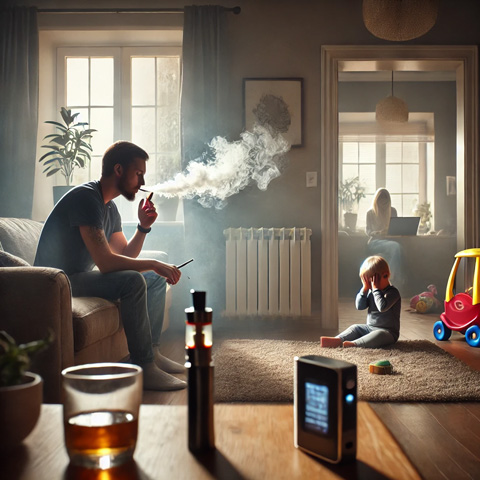
Wild Fire Smoke
Growing Health Risks of Wildfire and Structure Fire Smoke
Wildfires and structural fires have become an increasing threat not only in the western United States but across the entire nation. Water scarcity, poor vegetation management, dry conditions and urban expansion pushes more communities into fire-prone areas, the risk of exposure to dangerous smoke has never been greater. While wildfire smoke has long been recognized as a public health hazard, the added toxicity of burning buildings, which contain plastics, chemicals, and other synthetic materials, presents an even greater danger. These fires release a lethal mix of volatile organic compounds (VOCs) and carcinogenic gases that can have both immediate and long-term effects on human health.
Even after a fire has been extinguished, the health risks persist. Soot and debris from large building fires can linger in the environment and circulate in the air for over a year. These fine particles can be drawn into homes and businesses through HVAC systems when they bring in external air, leading to continued exposure long after the initial blaze. Understanding these risks is crucial as wildfires and urban fires become more frequent and devastating, impacting not just the West but communities nationwide.
The Health Hazards of Wildfire Smoke
Wildfire smoke is a complex mixture of fine particulate matter (PM2.5), carbon monoxide, nitrogen oxides, and various organic chemicals. The small size of PM2.5 particles allows them to penetrate deep into the lungs and even enter the bloodstream, leading to a range of health problems, including:
- Respiratory Issues: Short-term exposure to wildfire smoke can cause coughing, wheezing, throat irritation, and shortness of breath, particularly for those with asthma, chronic obstructive pulmonary disease (COPD), or other respiratory conditions.
- Cardiovascular Problems: Fine particulate matter from smoke has been linked to an increased risk of heart attacks, strokes, and other cardiovascular complications, especially for older adults and individuals with pre-existing heart conditions.
- Immune System Effects: Exposure to wildfire smoke has been shown to weaken the immune system, making people more vulnerable to respiratory infections, including pneumonia and bronchitis.
- Neurological Impact: Emerging research suggests that air pollution, including wildfire smoke, may contribute to cognitive decline and an increased risk of neurodegenerative diseases such as Alzheimer’s and Parkinson’s.
The Added Toxicity of Burning Buildings
While wildfire smoke is hazardous on its own, the burning of residential and commercial buildings introduces an entirely new level of toxicity. Unlike wildfires, which primarily burn trees and vegetation, structure fires release an immense variety of dangerous chemicals due to the combustion of modern materials such as plastics, synthetic fabrics, treated wood, electronics, and industrial chemicals.
Key Toxic Components in Structure Fire Smoke:
- Volatile Organic Compounds (VOCs): Many household products, including furniture, flooring, and electronics, contain VOCs such as benzene, toluene, and formaldehyde. When burned, these chemicals become airborne and are easily inhaled, causing headaches, dizziness, nausea, and long-term damage to the liver and kidneys.
- Carcinogenic Gases: Burning plastics and synthetic materials release known carcinogens such as dioxins, polycyclic aromatic hydrocarbons (PAHs), and formaldehyde, which can increase the risk of developing lung cancer, leukemia, and other cancers over time.
- Heavy Metals: Electronics, batteries, and wiring contain toxic metals like lead, mercury, and cadmium. When these materials burn, they release fumes that can damage the nervous system, cause developmental delays in children, and lead to long-term cognitive impairment.
- Cyanide Gas: Many household products contain nitrogen-based materials, which, when burned, release hydrogen cyanide—a deadly gas that can interfere with the body’s ability to use oxygen, leading to suffocation and death in high concentrations.
- Asbestos and Silica: Older buildings, particularly those built before the 1980s, may contain asbestos insulation and lead-based paints. When structures burn or collapse, these materials can become airborne and pose serious risks for inhalation, leading to lung diseases such as asbestosis and mesothelioma.
The Long-Term Impact of Fire Debris and Soot
One of the lesser-known but equally dangerous consequences of large fires is the long-term presence of soot and debris in the area of the fires. After a major building fire, microscopic particulates can remain suspended in the atmosphere for months or even over a year. These particles do not simply dissipate; instead, they continue to circulate through wind patterns and weather changes. Even when these particulates land, they can subsequently be reintroduced to the air due to wind currents.
A significant concern is that many homes and businesses rely on HVAC systems that draw in external air. Without proper filtration, these systems can pull in soot, toxic chemicals, and residual pollutants from past fires, reintroducing them into indoor environments. This means that even if a fire occurred miles away or months earlier, people can still be exposed to hazardous particulates as they unknowingly breathe in contaminated air.
The Growing Threat Beyond the West
Historically, wildfires have been most common in the western U.S., particularly in California, Oregon, and Washington. However, climate change and shifting weather patterns have contributed to an increasing number of fires in the Midwest, the South, and even the Northeast. The 2023 Canadian wildfires sent massive plumes of toxic smoke across the U.S., affecting cities as far as New York and Washington, D.C., and causing some of the worst air quality levels ever recorded in these regions.
Additionally, as urbanization increases and more communities are built in fire-prone areas, the risk of structure fires spreading into populated neighborhoods is growing. This means more exposure to the highly toxic compounds released by burning buildings, posing long-term health risks to entire populations.
Mitigating the Risks with Advanced Air Purification
As wildfires and structure fires become more frequent and widespread, it is crucial to take steps to mitigate the risks of smoke exposure. One of the most effective strategies is improving indoor air quality through advanced air purification systems.
The Hummingbird Indoor Air Purification System
While traditional air purifiers primarily filter out particulates, the Hummingbird system offers a more advanced approach by not only trapping harmful particles but also breaking down dangerous VOCs (volatile organic compounds) and other toxic gases. This is a critical advantage when dealing with smoke from structure fires, which contains an array of chemical pollutants.
Key Benefits of the Hummingbird System:- VOC Breakdown: Unlike most air purifiers that only capture particles, the Hummingbird® system actively breaks down harmful chemicals and VOCs, reducing their concentration in indoor air.
- Carcinogen Removal: The system is designed to neutralize cancer-causing compounds like benzene and formaldehyde, providing added protection against long-term exposure.
- High-Efficiency Particulate Capture: It effectively removes PM2.5 and ultra-fine particles that penetrate deep into the lungs.
- Protection from Fire Debris: By continuously filtering indoor air, the system prevents lingering soot and debris from past fires from being reintroduced into homes and businesses through HVAC systems.
Conclusion
The increasing prevalence of wildfires and structure fires across the U.S. poses a growing threat to human health. While wildfire smoke alone is hazardous, the burning of buildings adds a new dimension of toxicity, releasing VOCs, carcinogens, and heavy metals into the air. Additionally, soot and debris from large fires can remain in circulation for extended periods, exposing communities to ongoing risks.
As these disasters become more common due to climate change and urban expansion, it is critical to raise awareness of these risks, implement protective measures, and push for stronger policies to mitigate exposure. Investing in advanced indoor air purification systems like the Hummingbird can provide a powerful defense against these invisible threats, offering cleaner, healthier air for families, businesses, and first responders alike. The health effects of toxic fire smoke are not just a regional issue confined to the West—it is a national crisis that requires urgent attention.
 Air Quality: Burning Buiding Toxic Funes
Air Quality: Burning Buiding Toxic Funes
Formaldehyde: Understanding Its Dangers, Sources, Detection, and Mitigation
What is Formaldehyde?
Formaldehyde (CH2O) is a colorless, flammable gas with a strong, pungent odor. It is a volatile organic compound (VOC) that is widely used in various industries, including construction, manufacturing, and healthcare. Formaldehyde is a key ingredient in the production of resins, adhesives, and preservatives. Due to its widespread use, it is commonly found in both indoor and outdoor environments, making it a significant concern for indoor air quality (IAQ).
The Dangers of Formaldehyde to Human Health
Formaldehyde is a well-documented health hazard. The U.S. Environmental Protection Agency (EPA) and the International Agency for Research on Cancer (IARC) classify formaldehyde as a Group 1 carcinogen, meaning it is known to cause cancer in humans. The health effects of formaldehyde exposure depend on the concentration and duration of exposure.
Short-Term Exposure Risks:
- Irritation of the eyes, nose, and throat – Even low levels can cause burning sensations and watery eyes.
- Respiratory symptoms – Coughing, wheezing, and shortness of breath can occur.
- Skin irritation – Direct contact can lead to allergic reactions or dermatitis.
Long-Term Exposure Risks:
- Increased risk of cancer – Long-term inhalation exposure has been linked to nasopharyngeal cancer and leukemia.
- Chronic respiratory issues – Persistent exposure may lead to asthma, chronic bronchitis, and other lung diseases.
- Neurological effects – Studies suggest prolonged exposure may lead to headaches, memory loss, and mood disturbances.
Where is Formaldehyde Found?
1. Building Materials and Furnishings:
- Pressed wood products – Plywood, particleboard, and fiberboard contain adhesives that release formaldehyde.
- Carpeting and flooring – Many synthetic carpets and laminate floors contain formaldehyde-based adhesives.
- Insulation materials – Certain foam insulations and fiberglass products contain formaldehyde.
2. Household Products:
- Cleaning agents and disinfectants – Many household cleaners contain formaldehyde or formaldehyde-releasing preservatives.
- Cosmetics and personal care products – Some shampoos, lotions, and nail polishes contain formaldehyde-releasing ingredients.
- Paints and varnishes – Solvents in paints, varnishes, and lacquers can emit formaldehyde.
3. Tobacco Smoke and Combustion Sources:
- Cigarette smoke – A major indoor source of formaldehyde.
- Gas stoves and fireplaces – Combustion appliances release small amounts of formaldehyde into indoor air.
4. Medical and Laboratory Use:
- Formalin solutions – Used for tissue preservation in medical and research settings.
- Sterilization processes – Some hospitals and laboratories use formaldehyde for sterilization.
Detecting Formaldehyde with the
Hummingbird® IAQ Indoor Air Quality Monitor
Accurately detecting formaldehyde is essential for maintaining a safe indoor environment. The Hummingbird® IAQ Indoor Air Quality Monitor is an advanced tool designed to measure and track airborne formaldehyde concentrations in real time. This device offers:
- High-precision formaldehyde detection – Ensures accurate readings of indoor air pollutants.
- Real-time monitoring – Alerts users when formaldehyde levels exceed safe thresholds.
- Comprehensive air quality analysis – Measures VOCs, particulate matter (PM2.5/PM10), CO2, temperature, and humidity.
- User-friendly interface – Provides easy access to air quality data via a digital display or smartphone app.
Mitigating Formaldehyde with the Hummingbird® System
Reducing indoor formaldehyde concentrations requires a combination of source control, ventilation, and advanced air purification technologies. The Hummingbird® air purification system is uniquely designed to eliminate formaldehyde using its photocatalytic oxidation (PCO) technology.
How Photocatalytic Oxidation Works to Decompose Formaldehyde
- A Titanium Dioxide (TiO2) Catalyst:
- When exposed to UV light, the catalyst initiates an oxidation reaction that breaks down formaldehyde molecules.
- When exposed to UV light, the catalyst initiates an oxidation reaction that breaks down formaldehyde molecules.
- Oxidation of Formaldehyde (CH₂O):
- Formaldehyde reacts with hydroxyl radicals (OH•) and oxygen species, breaking down into carbon dioxide (CO₂) and water (H₂O), which are safe for human health.
- Formaldehyde reacts with hydroxyl radicals (OH•) and oxygen species, breaking down into carbon dioxide (CO₂) and water (H₂O), which are safe for human health.
- Continuous Air Purification:
- Unlike traditional filters that trap pollutants, the PCO process actively decomposes formaldehyde, preventing re-release into the air.
- Unlike traditional filters that trap pollutants, the PCO process actively decomposes formaldehyde, preventing re-release into the air.
Additional Benefits of Hummingbird® Air Purification:
- Removes VOCs and airborne pathogens – Eliminates viruses, bacteria, and other pollutants.
- HEPA Filtration - Captures 99.97% of airborne particulates, including PM2.5 and smaller.
- Activated Carbon Filters: Absorb volatile organic compounds (VOCs), odors, and toxic gases.
- Odor reduction – Neutralizes chemical odors from cleaning products, paints, and furnishings.
Conclusion
Formaldehyde is a dangerous airborne pollutant found in many indoor environments, posing serious health risks. Understanding its sources, health effects, and detection methods is crucial for effective indoor air quality management. By utilizing the Hummingbird® IAQ Indoor Air Quality Monitor for real-time detection and the Hummingbird® system with photocatalytic oxidation, individuals can ensure cleaner, healthier indoor air and protect their well-being.

© Energy Cloud Inc.
Air Quality: Formaldehyde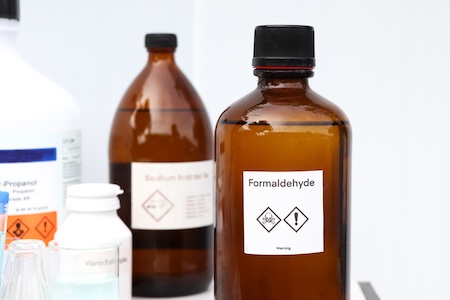
© Chemical Lab
Sick Building Syndrome: (SBS)
Causes, Symptoms, & Comprehensive Air Quality Strategy
Understanding Sick Building Syndrome (SBS)
Sick Building Syndrome (SBS) is a condition where building occupants experience acute health and comfort issues that seem to be linked to time spent in a specific building, but no specific illness or cause can be identified. Unlike identifiable medical conditions caused by contaminants like asbestos or mold, SBS is characterized by a range of nonspecific symptoms that improve when individuals leave the affected environment.
Symptoms of Sick Building Syndrome
- Headaches and dizziness
- Fatigue and difficulty concentrating
- Eye, nose, and throat irritation
- Dry, itchy skin or rashes
- Nausea
- Sensitivity to odors
- Coughing or shortness of breath
These symptoms typically worsen during prolonged exposure to the affected environment and improve upon leaving the building.
Causes of Sick Building Syndrome
- Inadequate Ventilation – Poor airflow and circulation can lead to a buildup of indoor pollutants and a lack of fresh air.
- Chemical Contaminants – Emissions from cleaning products, paints, carpets, adhesives, and office equipment can release volatile organic compounds (VOCs) into the air.
- Biological Contaminants – Mold, bacteria, pollen, and viruses can accumulate in HVAC systems and indoor spaces, leading to respiratory issues.
- Airborne Particulates – Dust, smoke, and fine particulate matter (PM0.5, PM1, PM2.5, PM4, PM10) can trigger allergies and respiratory distress.
- Ozone and Ionization-Based Air Purification – Some air purification methods, such as ozone generators and ionization, can produce harmful byproducts, exacerbating SBS symptoms instead of alleviating them.
Comprehensive Air Quality Strategy for Treating and Preventing SBS
1. Implementing Advanced Air Purification
One of the most effective ways to combat SBS is to use Hummingbird® Air Purification Systems. These systems utilize photocatalytic oxidation (PCO) to eliminate a broad range of airborne contaminants, including VOCs, bacteria, viruses, and particulate matter, without producing harmful byproducts.
2. Continuous Air Quality Monitoring
The Hummingbird® IAQ Air Quality Monitor provides real-time, continuous monitoring of 18 different air quality and environmental conditions, including:
- VOC levels
- Particulate matter (PM0.5, PM1, PM2.5, PM4, PM10)
- Carbon dioxide (CO2)
- Formaldehyde (HCHO)
- Nitrogen oxides (NOx)
- Humidity, Temperature & Pressure
- Other airborne pollutants
3. Ventilation and Fresh Air Exchange
Proper ventilation is key to preventing SBS. Integrating the Hummingbird® IAQ Air Quality Monitor with HVAC systems enables smart ventilation control, ensuring that fresh air is introduced when necessary while maintaining energy efficiency.
One of the most critical factors in proper ventilation is air changes per hour (ACH), which measures how many times indoor air is replaced with fresh air per hour. A higher ACH rate helps dilute CO2 levels, reducing occupant fatigue, improving cognitive function, and promoting overall well-being.
4. Certifying Healthy Buildings with A+ Air Quality Certification
The Hummingbird® IAQ Air Quality Monitor can also be used to certify a building’s health with its patented A+ Air Quality Certification. This certification assures occupants that their building maintains superior air quality standards.
Conclusion
Sick Building Syndrome is a significant concern in modern workplaces, homes, and public spaces. By implementing a comprehensive air purification and air quality monitoring strategy, such as the Hummingbird® Air Purification System and IAQ Monitor, building managers can effectively eliminate the causes of SBS and ensure a consistently healthy environment.
Air Quality: Sick Building Syndrome
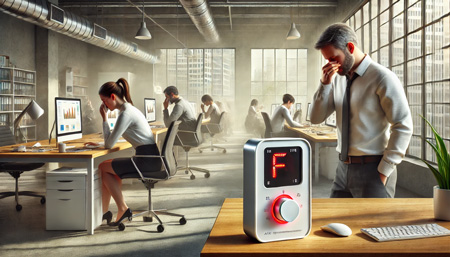
Carbon Monoxide (CO) Dangers and Mitigation
Carbon monoxide (CO) is an odorless, colorless gas that poses significant health risks both indoors and outdoors. According to the Centers for Disease Control and Prevention (CDC), each year, more than 400 Americans die from unintentional CO poisoning not linked to fires, more than 100,000 visit the emergency room, and more than 14,000 are hospitalized.1
Indoor Dangers and Causes
Common indoor sources of CO include malfunctioning fuel-burning appliances such as furnaces, water heaters, stoves, and fireplaces. Improper ventilation or faulty equipment can lead to CO accumulation, resulting in symptoms like headaches, dizziness, nausea, and, in severe cases, death.
Outdoor Dangers and Causes
Outdoors, CO is primarily emitted from vehicle exhaust and equipment like generators and grills. In areas with minimal air movement, such as garages or enclosed spaces, CO can accumulate to dangerous levels. Prolonged exposure can impair oxygen delivery to the body's organs, leading to serious health effects.
First Line of Defense: CO Detectors
The first line of defense against CO exposure is the installation of reliable CO detectors equipped with alert systems. Devices like the Hummingbird® IAQ Indoor Air Quality Monitor are designed with advanced CO sensors and alert mechanisms to provide real-time monitoring and immediate notifications of elevated CO levels. This proactive approach ensures that occupants are promptly informed of potential dangers, allowing for swift action to mitigate risks.
Mitigation through Photocatalytic Oxidation
The Hummingbird® Air Purification System employs photocatalytic oxidation (PCO) to mitigate CO levels. In this process, ultraviolet (UV) light interacts with a titanium dioxide (TiO₂) catalyst, producing reactive radicals that oxidize CO into less harmful carbon dioxide (CO₂). This method effectively reduces CO concentrations, enhancing indoor air quality.
Comprehensive Safety Strategy
By integrating such monitoring systems and advanced air purification technologies, individuals can establish a comprehensive strategy to maintain a safer and healthier indoor environment.
1 CDC Carbon Monoxide Poisoning Basics

Air Quality: Carbon Monoxide (CO)
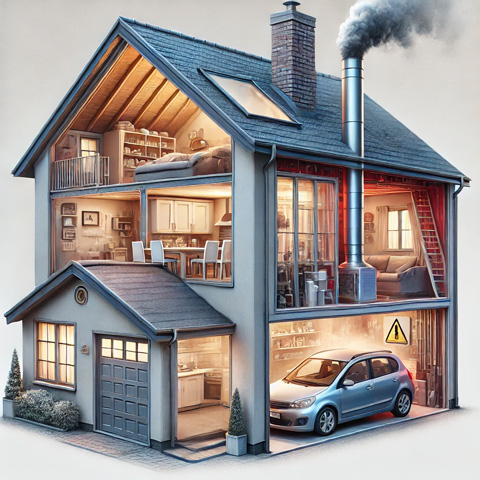 Air Quality: Carbon Monoxide (CO) Risks in a Home
Air Quality: Carbon Monoxide (CO) Risks in a Home
Carbon Dioxide (CO2)
The Effects of CO2 on Indoor Air Quality and Human Health
CO2 is a natural byproduct of human respiration and is generally present in indoor environments. However, inadequate ventilation can lead to the accumulation of CO2, particularly in enclosed spaces with high occupancy levels. When CO2 concentrations exceed 1000 ppm (parts per million), occupants may begin to experience discomfort, reduced concentration, and impaired decision-making abilities. Prolonged exposure to higher levels (above 2000 ppm) can result in drowsiness, increased heart rate, and even more severe health concerns.
The presence of CO2 is also an indicator of overall ventilation efficiency. When CO2 levels are high, it often signals that fresh air exchange is insufficient, which can also lead to an increase in other indoor pollutants such as volatile organic compounds (VOCs), allergens, and particulate matter. These pollutants further exacerbate indoor air quality issues, potentially triggering respiratory problems, allergies, and other health complications.
The Role of Indoor Air Quality Monitoring
To effectively manage indoor CO2 levels and overall air quality, continuous monitoring is essential. The Hummingbird® IAQ (Indoor Air Quality Monitor) is a state-of-the-art tool designed to measure key air quality parameters, including CO2 concentration, humidity, temperature, and other pollutants. By providing real-time data, this system allows building managers, homeowners, and facility operators to make informed decisions regarding ventilation and air purification needs.
The Hummingbird® IAQ (Indoor Air Quality Monitor) is particularly beneficial when integrated with HVAC and dedicated ventilation systems. By detecting elevated CO2 levels, it can communicate with these systems to bring in fresh external air, ensuring proper air exchange and maintaining optimal indoor air quality. This proactive approach not only enhances occupant comfort but also improves overall health and well-being by mitigating the risks associated with poor air quality.
The Hummingbird® Air Purification System:
Enhancing Indoor and Outdoor Air Quality
While ventilation is essential for reducing CO2 buildup, the quality of the incoming outdoor air must also be considered. Many external pollutants, including dust, pollen, industrial emissions, and vehicle exhaust, can compromise indoor air quality when brought in through ventilation systems. This is where the Hummingbird® Air Purification System plays a crucial role.
The Hummingbird® Air Purification System employs advanced photocatalytic oxidation (PCO) technology to eliminate airborne contaminants, neutralize VOCs, and reduce particulate matter. By purifying the incoming air from outside as well as the recirculated indoor air, this system ensures a cleaner and healthier environment. Its ability to remove harmful pollutants makes it an ideal complement to the Hummingbird IAQ Monitor and ventilation systems, creating a comprehensive indoor air quality solution.
Conclusion
Managing indoor air quality is essential for maintaining a healthy living and working environment. CO2 levels serve as a key indicator of ventilation effectiveness and overall air quality. Through real-time monitoring with the Hummingbird® IAQ Indoor Air Quality Monitor, occupants can proactively address air quality concerns by adjusting ventilation and filtration strategies. Additionally, the Hummingbird Air Purification System enhances indoor environments by purifying both incoming and circulating air, ensuring that harmful pollutants are effectively removed. Together, these systems provide a robust solution for maintaining optimal indoor air quality, promoting health, comfort, and well-being for all occupants.
